 W
WAlecton is a genus of firefly in the beetle family Lampyridae. The species A. discoidalis is the best known of the four species in the genus.
 W
WAlecton discoidalis is a species of firefly in the beetle family Lampyridae, commonly known as the Cuban endemic firefly. The larvae of this species are predators on both pulmonate and operculate land snails. Alecton discoidalis is the type species of the genus Alecton.
 W
WAquatica lateralis, known as "heike-botaru" in Japanese, is a species of firefly found in Russia, Japan and Korea. It was formerly placed in the genus Luciola. The larvae are aquatic and live in rice paddies.
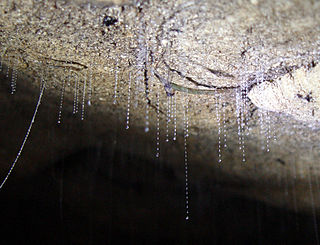 W
WArachnocampa is a genus of nine fungus gnat species which have a bioluminescent larval stage, akin to the larval stage of glowworm beetles. The species of Arachnocampa are endemic to Australia and New Zealand, dwelling in caves and grottos, or sheltered places in forests.
 W
WArachnocampa luminosa, commonly known as New Zealand glowworm or simply glowworm, is a species of fungus gnat endemic to New Zealand. The larval stage and the imago produce a blue-green bioluminescence. The species is known to dwell in caves and on sheltered banks in native bush where humidity is high. Its Māori name is titiwai, meaning "projected over water".
 W
WAspisoma is a genus of fireflies in the family Lampyridae. There are at least 70 described species in Aspisoma.
 W
WCladodes is a genus of firefly beetles.
 W
WDiaphanes is a genus of fireflies in the Lampyrinae subfamily. Species within this genus are:D. citrinus D. exsanguis D. formosus D. guttatus D. lampyroides D. limbatus D. marginella D. mendax D. nubilus D. pectinealis
 W
WThe Lampyridae are a family of insects in the beetle order Coleoptera with more than 2,000 described species. They are soft-bodied beetles that are commonly called fireflies, glowworms, or lightning bugs for their conspicuous use of bioluminescence during twilight to attract mates or prey. Fireflies produce a "cold light", with no infrared or ultraviolet frequencies. This chemically produced light from the lower abdomen may be yellow, green, or pale red, with wavelengths from 510 to 670 nanometers. Some species such as the dimly glowing "blue ghost" of the Eastern U.S. are commonly thought to emit blue light, although this is a false perception of their truly green emission light, due to the Purkinje effect.
 W
WIgnelater is a genus of click beetle. They are one of several genera in the tribe Pyrophorini, all of which are bioluminescent. Most of the species were formerly in the genus Pyrophorus.
 W
WIgnelater luminosus, known as the cucubano, is a species of click beetle native to the island of Puerto Rico. Cucubanos are often confused with fireflies, which are in a different family (Lampyridae), as they can also emit light from the thorax. Their paired prothorax light organs and single light organ on the anterior surface of the abdomen gives the appearance of two "headlights" and one "backlight", which it can turn off independently.
 W
WThe Lampyridae are a family of insects in the beetle order Coleoptera with more than 2,000 described species. They are soft-bodied beetles that are commonly called fireflies, glowworms, or lightning bugs for their conspicuous use of bioluminescence during twilight to attract mates or prey. Fireflies produce a "cold light", with no infrared or ultraviolet frequencies. This chemically produced light from the lower abdomen may be yellow, green, or pale red, with wavelengths from 510 to 670 nanometers. Some species such as the dimly glowing "blue ghost" of the Eastern U.S. are commonly thought to emit blue light, although this is a false perception of their truly green emission light, due to the Purkinje effect.
 W
WLampyris is a genus of beetles in the Lampyridae. In most of western Eurasia, they are the predominant members of this family and includes the European common glow-worm, which is the type species. They produce a continuous glow; the larvae and larviform females are among those organisms commonly called "glowworms".
 W
WLampyris noctiluca, the common glow-worm of Europe, is the type species of beetle in the genus Lampyris and the family Lampyridae.
 W
WLampyris raymondi is a firefly species of the genus Lampyris, belonging to the order Coleoptera.
 W
WLucidota is a genus of fireflies in the beetle family Lampyridae. There are more than 160 described species in Lucidota.
 W
WLucidota atra, the black firefly, is a species of firefly in the beetle family Lampyridae. It is found in Central America and North America.
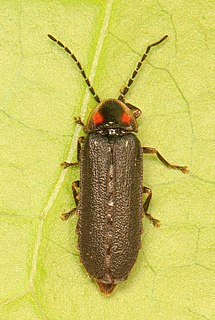 W
WLucidota punctata is a species of firefly in the beetle family Lampyridae. It is found in North America.
 W
WLuciola is a genus of "flashing" fireflies, especially well-known from Japan. They are often called "Japanese fireflies", but their members range farther into Asia and reach southern Europe and Africa. This genus is traditionally held to extend to Australia, but these species do not seem to belong herein.
 W
WLuciola cruciata, known as "genji-botaru" in Japanese, is a species of firefly found in Japan. Its habitat is small ditches and streams, and its larvae are aquatic.
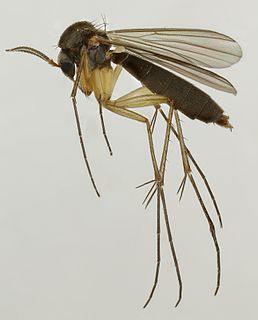 W
WThe Mycetophilidae are a family of small flies, forming the bulk of those species known as fungus gnats. About 3000 described species are placed in 150 genera, but the true number of species is undoubtedly much higher. They are generally found in the damp habitats favoured by their host fungi and sometimes form dense swarms.
 W
WOrfelia fultoni is one of the bioluminescent species of flies found in North America. It is distantly related to Arachnocampa, but their bioluminescent systems use distinct mechanisms. The larvae of the species live in stream banks among moss and rock cavities, as well as in wet sandstone caves. They build sticky webs, and using their two bioluminescent lanterns as an attractant, capture flying prey. They produce the bluest light of any studied bioluminescent insect. The species occurs in the Appalachian Mountains and Cumberland Plateau, primarily in the states of Alabama, North Carolina, Tennessee, and Virginia.
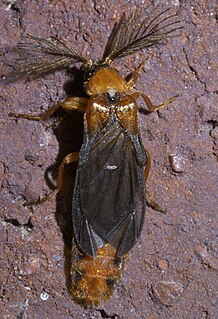 W
WPhengodes is a genus of glowworms in the beetle family Phengodidae. There are more than 30 described species in Phengodes.
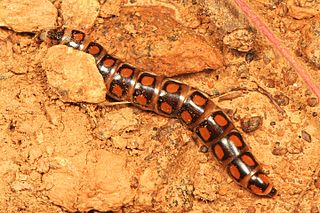 W
WPhengodes nigromaculata is a species of glowworm beetle in the family Phengodidae. It is found in North America.
 W
WPhengodes plumosa, known generally as the glow worm or railroad-worm, is a species of glowworm beetle in the family Phengodidae. It is found in North America.
 W
WThe beetle family Phengodidae is known also as glowworm beetles, whose larvae are known as glowworms. The females and larvae have bioluminescent organs. They occur throughout the New World from extreme southern Canada to Chile. The recently recognized members of the Phengodidae, the Cydistinae, are found in Western Asia. The family Rhagophthalmidae, an Old World group, used to be included in the Phengodidae.
 W
WPhosphaenus hemipterus, the short-winged firefly or lesser glow worm, is a beetle in the monotypic genus Phosphaenus and the family Lampyridae. It is found in the Mediterranean, in Central Europe, west to the Atlantic Ocean and north to the edge of Scandinavia and in England. In North America, the species has been introduced. It inhabits meadows, floodplains, forest edges, and dry slopes, but also parks and gardens. In Britain, this species is fairly rare compared to the common glow-worm.
 W
WThe rover fireflies (Photinus) are a genus of fireflies. They are the type genus of tribe Photinini in subfamily Lampyrinae. This genus contains, for example, the common eastern firefly, the state insect of Tennessee, United States.
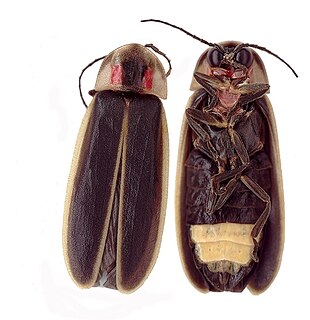 W
WPhotinus carolinus is a species of rover firefly whose mating displays of synchronous flashing have fascinated both scientists and tourists. As individual females synchronize with males nearby, waves of alternating bright light and darkness seem to travel across the landscape. Firefly displays typically occur in early June near Elkmont, Tennessee, in the Great Smoky Mountains National Park, near Gatlinburg.
 W
WPhotinus pyralis, known by the common names common eastern firefly and big dipper firefly, is the most common species of firefly in North America. P. pyralis is a flying and light-producing beetle with a light organ on the ventral side of its abdomen. This organism is sometimes incorrectly classified as Photuris pyralis, which likely results from mistaking the similar-sounding genus Photuris.
 W
WPhoturis is a genus of fireflies. These are the femme fatale lightning bugs of North America. This common name refers to a behavior of the adult females of these predatory beetles; they engage in aggressive mimicry, imitating the light signals of other firefly species' females to attract, kill, and eat the males. Their flashing bioluminescent signals seem to have evolved independently and eventually adapted to those of their prey, mainly unrelated Lampyrinae, such as Photinus or Pyractomena.
 W
WPhoturis pensylvanica, known by the common names Pennsylvania firefly, lightning bug, and glowworm, is a species of firefly from the United States and Canada. It is also widely known under the Latin name Photuris pennsylvanica, although the original spelling, with one "n", was common in Latinized names of the time and remains the valid name.
 W
WPleotomus is a genus of fireflies in the family Lampyridae. There are about five described species in Pleotomus.
 W
WPyractomena is a genus of fireflies in the family Lampyridae. There are at least 20 described species in Pyractomena.
 W
WPyractomena angulata is a species of firefly in the family of beetles known as Lampyridae. It is found in North America and is the state insect of Indiana. It is also known as Say's Firefly and the Angle Candled Firefly.
 W
WPyractomena borealis is a species of firefly in the beetle family Lampyridae. It is found in North America.
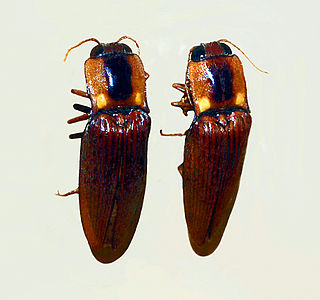 W
WPyrearinus is a genus of click beetle.
 W
WPyrearinus candelarius is a species of click beetle.
 W
WPyrophorus is a genus of click beetle. They are one of several genera in the tribe Pyrophorini, all of which are bioluminescent. Their bioluminescence is similar to that of another group of beetles, the fireflies, although click beetles do not flash, but remain constantly glowing. They have two luminescent spots at the posterior corners of the pronotum, and another brighter light organ on the most-anterior surface of the ventral abdomen. This light organ is even brighter and can only be seen when in flight. Bioluminescent click beetles are found throughout tropical, subtropical and temperate America. Species from Texas, Florida, Puerto Rico, and Cuba are now in different genera in the tribe Pyrophorini, such as Deilelater and Ignelater.
 W
WPyrophorus noctilucus, common name Headlight Elater, is a species of click beetle.
 W
WPyrophorus nyctophanus, aka headlight beetle or carbunco, is a species of click beetle that occurs on the cerrado of Brazil. Its luminescent larvae are either soil-dwelling or found in tunnels in the outer layers of termite mounds, and are active predators of other insects during summer nights when their regulated glow acts as a lure to their prey. The adult beetles, though, are phytophagous, feeding on decomposing plant matter and exudates, and are attracted to artificial light. Pupae of this genus also luminesce."Headlight beetles are large click beetles notable among click beetles in their unique ability to produce light. An intense glow emanates from two round luminescent organs on the prothorax and a broad area on the underside of the first abdominal segment. In flight both sexes produce a brilliant blue-green streak of light that dazzles the onlooker." -Charles Leonard Hogue
 W
WPyrophorus punctatissimus is a species of click beetle.
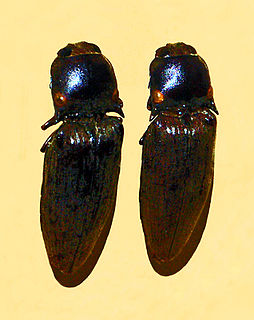 W
WPyrophorus tuberculifer is a species of click beetle.
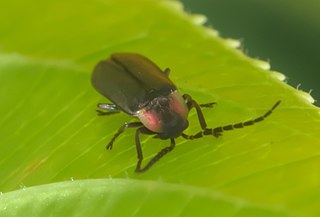 W
WPyropyga is a genus of fireflies in the beetle family Lampyridae. There are about 13 described species in Pyropyga.
 W
WA railroad worm is a larva or larviform female adult of a beetle of the genus Phrixothrix in the family Phengodidae, characterized by the possession of two different colors of bioluminescence. It has the appearance of a caterpillar. The eleven pairs of luminescent organs on their second thoracic segment through their ninth abdominal segment can glow yellowish-green, while the pair on their head can glow red; this is due to different luciferases in their bodies, as the reaction substrate, called luciferin, is the same.
 W
WZarhipis is a genus of glowworm beetles in the family Phengodidae. There are at least three described species in Zarhipis, all restricted to the western regions of North America.
 W
WZarhipis integripennis, the western banded glowworm, is a species of glowworm beetle in the family Phengodidae. It is found in North America.